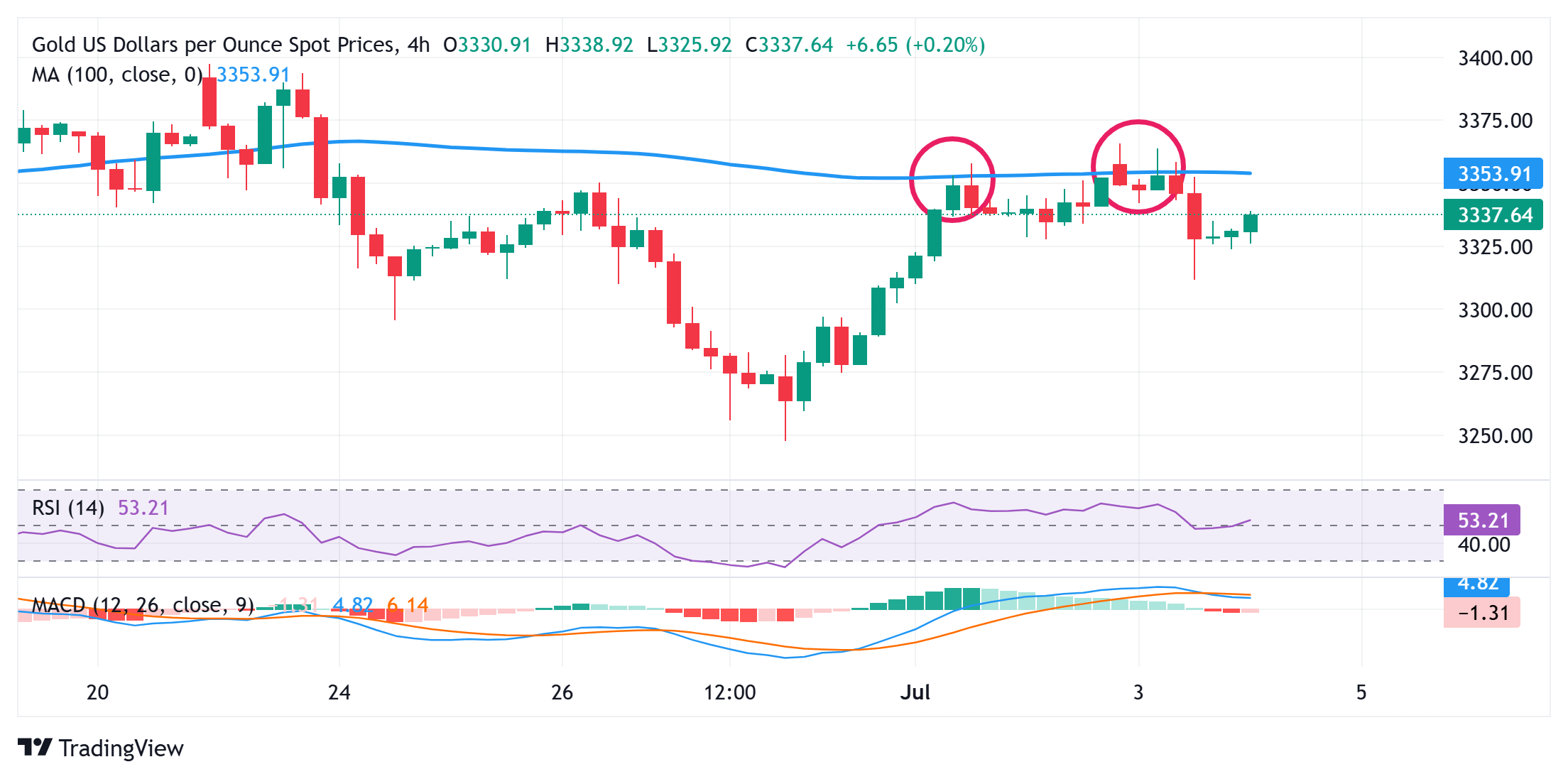- Gold price regains positive traction and reverses a part of Thursday’s upbeat NFP-inspired losses.
- US fiscal concerns weigh on the USD and lend support to the commodity amid trade uncertainties.
- Holiday-thinned liquidity might hold back the XAU/USD traders from placing fresh directional bets.
Gold price (XAU/USD) attracts some dip-buying on Friday and reverses a part of the previous day’s retracement slide from a one-and-a-half-week high. The US Dollar (USD) struggles to capitalize on Thursday’s post-NFP gains amid concerns that US President Donald Trump’s ‘One Big Beautiful Bill’ would worsen the country’s fiscal situation. This, along with persistent trade-related uncertainties further underpins the safe-haven precious metal.
Meanwhile, traders dialled back expectations that the Federal Reserve (Fed) will cut interest rates in July following the release of a stronger-than-expected US jobs report. This, along with a generally positive risk tone, might hold back the XAU/USD bulls from placing aggressive bets and cap gains. Nevertheless, the Gold price maintains its bid tone heading into the European session and remains on track to end in the green for the first time in three weeks.
Daily Digest Market Movers: Gold price benefits from softer USD, safe-haven buying
- The US Dollar touched a one-week high on Thursday after the US Bureau of Labor Statistics reported that Nonfarm Payrolls increased by 147,000 in June, beating forecasts of 111,000. Adding to this, the Unemployment Rate edged down to 4.1%, from 4.2% in May, and dashed hopes of an early interest rate cut by the Federal Reserve.
- Other details of the report showed that wage growth, as measured by the change in the Average Hourly Earnings, slowed to 0.2% in June from 0.4% previously and retreated to 3.7% from 3.8% in May. This helps to ease inflation concerns and keeps the door open for at least two 25 basis points rate reductions by the end of this year.
- US President Donald Trump’s tax-cut and spending bill cleared its final hurdle in Congress on Thursday. According to the nonpartisan Congressional Budget Office, the legislation will add $3.4 trillion to the nation’s debt. This could further worsen America’s long-term debt problems, which caps the USD and supports the Gold price.
- Meanwhile, Trump said that he plans to start sending letters informing trading partners of their tariff rates as soon as Friday, as negotiations to avoid higher US levies enter the final stretch. His comments come days before the July 9 deadline for steeper reciprocal tariffs and further act as a tailwind for the safe-haven precious metal.
- US markets will be closed on Friday in observance of Independence Day, warranting caution before placing aggressive bets around the XAU/USD amid the holiday-thinned liquidity. Nevertheless, the commodity remains on track to snap a two-week losing streak and the supportive fundamental backdrop favors bullish traders.
Gold price technical setup favors bulls; acceptance above 100-SMA on H4 awaited

From a technical perspective, this week’s repeated failures to build on the momentum beyond the 100-period Simple Moving Average (SMA) on the 4-hour chart warrant some caution for the XAU/USD bulls. The said barrier is currently pegged near the $3,352-3,355 area and should act as a key pivotal point. This is closely followed by the overnight swing high, around the $3,365-3,366 region, above which the Gold price could aim to reclaim the $3,400 round figure.
On the flip side, the $3,326-3,325 area now seems to protect the immediate downside ahead of the $3,311-3,310 region and the $3,300 round figure. A convincing break below the latter might shift the near-term bias in favor of bearish traders and make the Gold price vulnerable to accelerate the slide to the next relevant support near the $3,270 horizontal zone. The downward trajectory could extend further towards retesting the monthly swing low, around the $3,248-3,248 region.
Fed FAQs
Monetary policy in the US is shaped by the Federal Reserve (Fed). The Fed has two mandates: to achieve price stability and foster full employment. Its primary tool to achieve these goals is by adjusting interest rates.
When prices are rising too quickly and inflation is above the Fed’s 2% target, it raises interest rates, increasing borrowing costs throughout the economy. This results in a stronger US Dollar (USD) as it makes the US a more attractive place for international investors to park their money.
When inflation falls below 2% or the Unemployment Rate is too high, the Fed may lower interest rates to encourage borrowing, which weighs on the Greenback.
The Federal Reserve (Fed) holds eight policy meetings a year, where the Federal Open Market Committee (FOMC) assesses economic conditions and makes monetary policy decisions.
The FOMC is attended by twelve Fed officials – the seven members of the Board of Governors, the president of the Federal Reserve Bank of New York, and four of the remaining eleven regional Reserve Bank presidents, who serve one-year terms on a rotating basis.
In extreme situations, the Federal Reserve may resort to a policy named Quantitative Easing (QE). QE is the process by which the Fed substantially increases the flow of credit in a stuck financial system.
It is a non-standard policy measure used during crises or when inflation is extremely low. It was the Fed’s weapon of choice during the Great Financial Crisis in 2008. It involves the Fed printing more Dollars and using them to buy high grade bonds from financial institutions. QE usually weakens the US Dollar.
Quantitative tightening (QT) is the reverse process of QE, whereby the Federal Reserve stops buying bonds from financial institutions and does not reinvest the principal from the bonds it holds maturing, to purchase new bonds. It is usually positive for the value of the US Dollar.

